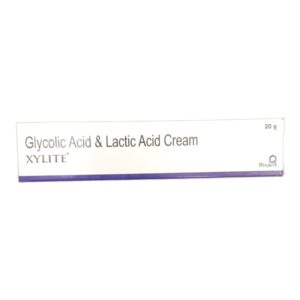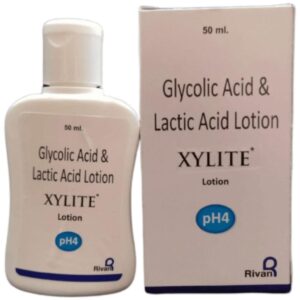LACTIC ACID + GLYCOLIC ACID
Lactic Acid: Lactic Acid, also known as lactate, is a natural compound found in the muscles and blood. It is primarily used as a medication for sports-related muscle pain and as a treatment for certain skin conditions.
Lactic Acid works by indirectly reducing the formation of lactic acid in the muscles, which helps to alleviate pain and discomfort associated with exercise or muscle strain. It also acts as a peeling agent when applied topically to the skin, helping to exfoliate dead skin cells and promote cell turnover.
The dose of Lactic Acid depends on the formulation and intended use. For muscle pain relief, it is typically applied topically in the form of gels, creams, or sprays. The recommended frequency of application may vary, but it is usually used up to three times per day as needed. For skin conditions, Lactic Acid is often found in moisturizers or peeling solutions, and the recommended use will vary depending on the specific product and condition being treated. It is important to follow the instructions provided by the healthcare professional or product label for proper dosage.
When used topically, Lactic Acid may cause temporary mild side effects such as stinging, burning, or redness at the site of application. These effects are usually minor and subside over time. However, if severe irritation or allergic reactions occur, it is important to discontinue use and seek medical attention.
It is worth noting that Lactic Acid should not be used on open wounds, broken skin, or areas of the skin with active infection. It is also recommended to avoid sun exposure or use protective measures such as sunscreen when using Lactic Acid topically, as it may increase sensitivity to sunlight.
Overall, Lactic Acid is a commonly used drug for muscle pain relief and skin exfoliation. However, it is essential to consult with a healthcare professional or read product instructions carefully before use to ensure proper administration and avoid any potential adverse effects.
Glycolic Acid: Glycolic acid is a type of alpha hydroxy acid (AHA) that is commonly used in skincare products and in professional chemical peels. It is derived from sugarcane and belongs to the class of exfoliating agents.
Glycolic acid is primarily used for its exfoliating properties, making it effective in treating various skin concerns such as acne, hyperpigmentation, fine lines, and wrinkles. It works by loosening and removing the outer layer of dead skin cells, promoting cell turnover, and stimulating the production of collagen. This rejuvenates the skin, making it smoother, brighter, and more even-toned.
The concentration of glycolic acid can vary depending on the product or treatment being used. In over-the-counter skincare products, the concentration typically ranges from 5% to 15%. Professional chemical peels can have higher concentrations up to 70%, but these should only be performed by trained professionals.
When using glycolic acid as part of a skincare routine, it is recommended to start with a lower concentration and gradually increase the frequency and concentration based on your skin’s tolerance. It is important to follow the instructions provided by the product manufacturer or consult a dermatologist for personalized guidance.
Common side effects of using glycolic acid include mild irritation, redness, and stinging sensation, especially for those with sensitive skin. These side effects are usually temporary and subside with regular use. However, if you experience severe or persistent burning, itching, or blistering, it is advisable to discontinue use and seek medical assistance.
It is important to note that glycolic acid increases the skin’s sensitivity to sunlight, so it is crucial to apply a broad-spectrum sunscreen with at least SPF 30 when using glycolic acid products. This helps protect the skin from potential damage caused by UV radiation.
Overall, glycolic acid is a widely used skincare ingredient that offers multiple benefits for various skin concerns. However, it is important to use it properly and monitor your skin’s response to ensure optimal results and minimize any potential side effects.



